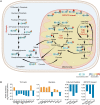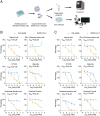The global succinylation of SARS-CoV-2-infected host cells reveals drug targets
- PMID: 35858407
- PMCID: PMC9335334
- DOI: 10.1073/pnas.2123065119
The global succinylation of SARS-CoV-2-infected host cells reveals drug targets
Abstract
SARS-CoV-2, the causative agent of the COVID-19 pandemic, undergoes continuous evolution, highlighting an urgent need for development of novel antiviral therapies. Here we show a quantitative mass spectrometry-based succinylproteomics analysis of SARS-CoV-2 infection in Caco-2 cells, revealing dramatic reshape of succinylation on host and viral proteins. SARS-CoV-2 infection promotes succinylation of several key enzymes in the TCA, leading to inhibition of cellular metabolic pathways. We demonstrated that host protein succinylation is regulated by viral nonstructural protein (NSP14) through interaction with sirtuin 5 (SIRT5); overexpressed SIRT5 can effectively inhibit virus replication. We found succinylation inhibitors possess significant antiviral effects. We also found that SARS-CoV-2 nucleocapsid and membrane proteins underwent succinylation modification, which was conserved in SARS-CoV-2 and its variants. Collectively, our results uncover a regulatory mechanism of host protein posttranslational modification and cellular pathways mediated by SARS-CoV-2, which may become antiviral drug targets against COVID-19.
Keywords: NSP14; SARS-CoV-2; SIRT5; antiviral; succinylproteomics.
Conflict of interest statement
The authors declare no competing interest.
Figures






References
-
- Blachere N. E., Hacisuleyman E., Darnell R. B., Vaccine breakthrough infections with SARS-CoV-2 variants. Reply. N. Engl. J. Med. 385, e7 (2021). - PubMed
Publication types
MeSH terms
Substances
LinkOut - more resources
Full Text Sources
Medical
Miscellaneous

